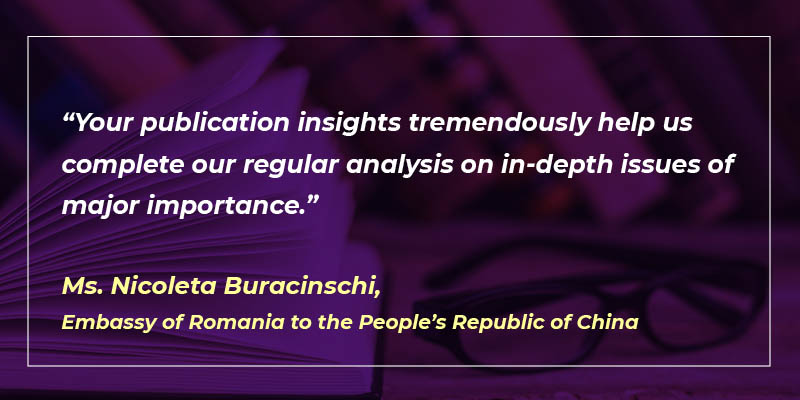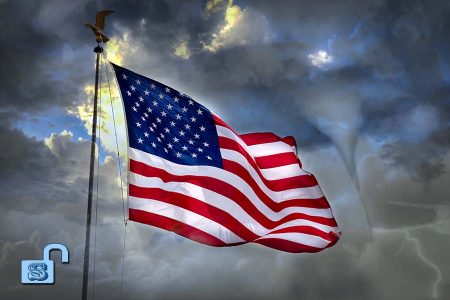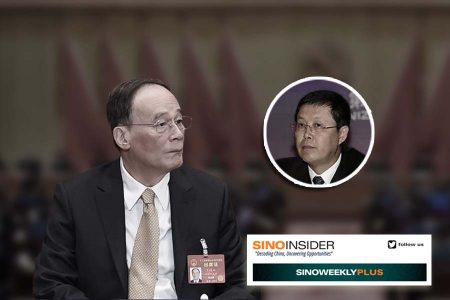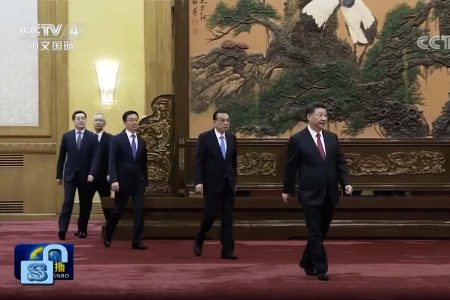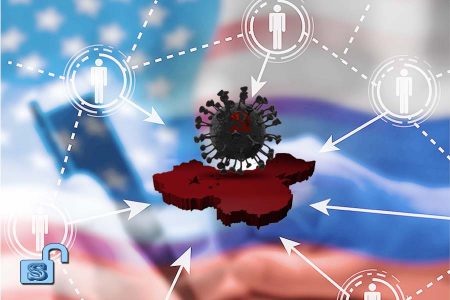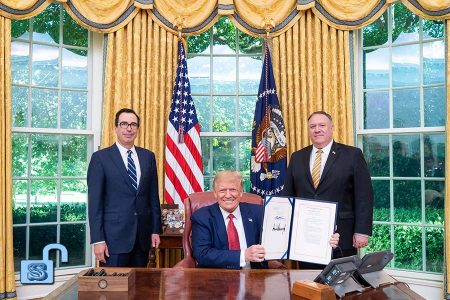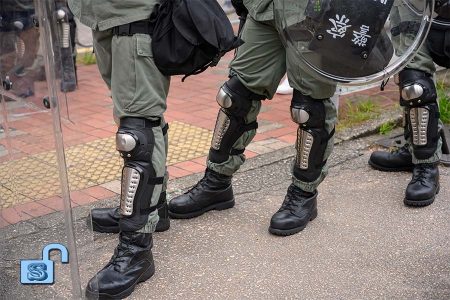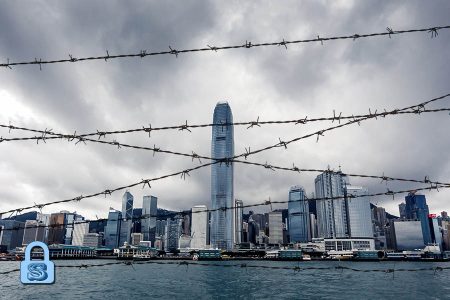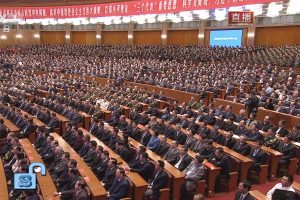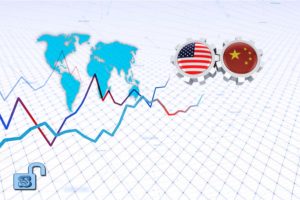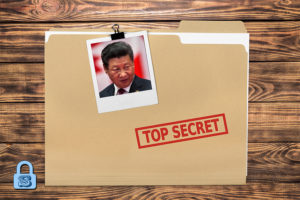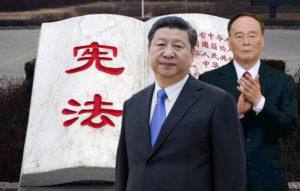◎ We made 36 predictions covering eight topics in our China 2023 Outlook. Thirty-one of those predictions were verified over the year, giving us a forecasting accuracy of 86.1 percent.
China’s economy failed to bounce back in 2023 despite the conclusion of the “zero-COVID” policy early in the year, just as we anticipated in our annual outlook. Other demographic and economic-related forecasts that we made also came to pass, including a worsening of China’s real estate crisis, increased pressure on the technology sector, slowing exports, and a shrinking population.
Meanwhile, the PRC’s relations with the United States and the West continued to deteriorate, particularly with the U.S. and its allies imposing stricter restrictions and sanctions on Chinese companies, as well as stepping up efforts to counter the PRC in the Indo-Pacific.
Politics: 3 predictions, 2 verified
1. Factional struggle in the CCP elite could enter a showdown phase as the PRC’s internal and external problems deepen. Xi Jinping’s enemies, especially “anti-Xi, not anti-CCP” forces in China and abroad, could intensify their attacks on Xi. Enemies of Xi will look to hold him accountable for his policy failures and could even blame him for all of the CCP’s crimes and evils (including Jiang Zemin’s negative political legacy). VERIFIED
- July
July 25: PRC foreign minister Qin Gang was removed from his position after just seven months. We analyzed that factional struggle in the CCP elite could be a factor behind Qin’s removal (see here and here).
***
A massive corruption scandal in the People’s Liberation Army broke out in July, implicating senior officials like former defense minister Li Shangfu, former PLA Rocket Force commanders Li Yuchao and Zhou Yanining, four defense industry executives in the Chinese People’s Political Consultative Conference, and seven military deputies to the National People’s Congress. All of the aforementioned individuals were removed from their respective positions and even stripped of their rank. We analyzed that factional struggle in the CCP elite could be a factor behind the exposure of corruption in the PLA.
***
Overseas Chinese commentators and media outlets harshly criticized Xi Jinping over the cases of Qin Gang, Li Shangfu, and corruption in the PLA.
- October
Oct. 27: Former PRC premier Li Keqiang passed away at the relatively young age of 68. Li’s death sparked criticism of political regression under Xi Jinping and speculation that Li was “assassinated” by Xi.
***
Taiwanese media Liberty Times published a piece by Australia-based Chinese dissident and jurist on Jan. 3, 2024 where the latter claimed that a group of “second generation reds” led by Liu Yuan had united in opposition to Xi. Yuan said he learned about the information at the end of 2023.
- December
Dec. 14: Asia Sentinel reported that the PRC authorities’ investigation into the People’s Liberation Army Rocket Force has led to the arrest of at least 70 individuals, citing an analyst from Canadian geopolitical consulting firm Cercius Group.
Dec. 29: The seventh meeting of the Standing Committee of the 14th National People’s Congress removed nine military generals as deputies of the body and from other positions.
Dec. 27: The 12th chairman’s meeting of the 14th National Committee of the Chinese People’s Political Consultative Conference revoked the seats of three defense industry executives.
Dec. 31: Sing Tao Daily reported that the PLARF scandal involved at least seven full generals, at least 30 senior military officers at the major general rank and higher, and even more military cadres at the division level.
Australia-based Chinese dissident and jurist Yuan Hongbing said in a March 12, 2024 interview that the PLA corruption scandal in 2023 involved Jiang Zemin’s eldest son Jiang Mianheng and Jiang faction officials. Yuan added that Xi is undecided on whether to use the cases to thoroughly purge Jiang Zemin politically.
2. Beijing’s new round of “rectification” campaigns will likely target officials in the political and legal affairs apparatus, the financial system, and state-owned enterprises. Active or retired Party or national-level leaders may even be investigated. VERIFIED
- Qin Gang and Li Shangfu, two sub-national-level officials (sub-national-level officials are considered national leaders in the PRC), were placed under investigation.
- In 2023, 104 officials in the financial system were investigated, a jump from the over 70 officials probed in 2022. The banking sector was hardest hit by the anti-corruption campaign, with 70 of the 104 officials (67.3 percent) previously having worked in banking. And of the 70 officials, 36 were from the five major state-owned banks.
- In 2023, the anti-corruption authorities disciplined 375 officials from state-owned enterprises and transferred 109 of them to the judicial authorities.
3. Xi Jinping could make shocking and subversive moves as the CCP regime faces increasing internal and external pressures and there are urgent calls for Xi to step down. Otherwise, Xi could be ousted from office.
Economy: 12 predictions, 12 verified
1. Financial institutions and investors could bet on the Chinese economy recovering under the expectation that things will return to normal with the easing of “zero-COVID.” However, signs of a quick recovery will likely be illusory as the Chinese economy continues to deteriorate and people lose confidence in China’s economic prospects. VERIFIED
- January
Jan. 18: Standard Chartered chairman José Viñals told CNBC, “In the second half of the year, I think that the Chinese economy is going to be on fire and that is going to be very, very important for the rest of the world.”
- February
The Wall Street Journal reported that global investors added more than $2 billion on a net basis to U.S.-based mutual and exchange-traded funds that buy Chinese equities, betting that China’s reopening would keep pushing the markets higher.
- Rhodium Group director Logan Wright believed that China “significantly overstated” its growth in 2023, and that the real figure was likely around 1.5 percent.
- SinoInsider estimated that China’s actual GDP growth in 2023 was negative 4.7 percent, using the CCP authorities’ method for calculating real GDP growth.
2. China’s population crisis will become more obvious. The CCP will resort to authoritarian means to reverse this trend, but those measures will be “too little, too late” and will likely result in more social problems. VERIFIED
- January
- Several localities in China lifted the marriage requirement to register a birth.
- The health and family planning bureau of Zezhou County in Shanxi Province stipulated that extra high school examination points will be awarded to second and third childs born after Jan. 30, 2023.
- The Sichuan provincial health commission issued a notice stating that married couples and individuals who wish to have children (regardless of marital status) can register with the government starting from Feb. 15, 2023, with no limit on the number of children that can be registered. The notice said that the move was meant to “promote long-term and balanced population development.”
- May
Per incomplete statistics compiled from mainland media, 23 localities in China were offering subsidies for couples with a second child and 29 localities were offering subsidies for couples with a third child as of May 25, 2023. Just five localities only offered subsidies to couples with one child. Wuhan’s East Lake High-tech Development Zone in Hubei Province offered the most subsidies, where families with a third child or more after Jan. 1, 2023 eligible to receive an annual child care subsidy of 10,000 yuan per child until the child reaches six years of age.
- June
Several local governments in China defined women aged 15 to 49 as those of “childbearing age” in their policies promoting childbirth.
- Per official data, the number of births in China dropped from 9.56 million in 2022 to 9.02 million in 2023.
3. China’s real estate crisis will worsen further and the CCP will find it difficult to turn things around even as it introduces various stimulus and rescue policies. As the crisis deepens, some large Chinese real estate companies could fall into technical bankruptcy and be taken over or restructured by the CCP authorities. VERIFIED
- August
Aug. 8: The Shanghai Third Intermediate People’s Court issued a decision to accept the bankruptcy liquidation application filed by Shanghai Hongkun Weiye Real Estate Development Co. Ltd., one of the top 100 real estate companies in China.
Aug. 17: China Evergrande, once a leading Chinese real estate firm, filed for bankruptcy protection in New York. Evergrande later withdrew its bankruptcy protection application in the U.S. after the Hong Kong High Court issued an order for the company to liquidate on Jan. 29, 2024.
- Dec. 20: China Aoyuan Group Ltd., which ranked 25th among China’s top 100 real estate companies in 2020, filed for bankruptcy protection in New York.
- A search for “real estate” on the state-run People’s Court Announcement website showed that approximately 233 real estate companies had issued bankruptcy related documents in 2023.
4. China’s technology sector will face greater survival pressures as compared to 2022. Large internet companies and other technology firms could continue to make significant layoffs to sustain operations. The internet platform economy faces bleak prospects. VERIFIED
- In 2023, Alibaba laid off about 15,000 employees, or approximately 6 percent of its workforce; Tencent laid off around 10,000 employees, or about 5 percent of its workforce; JD.com laid off approximately 6,000 to 8,000 employees, or around 10 percent of its workforce; and Meituan laid off around 5,000 to 7,000 employees, or about 10 percent of its workforce.
- In 2023, major Chinese internet platform companies saw significant changes in their market value. Tencent Holdings’ market value decreased by 27 percent (about 2.85 trillion yuan); Alibaba’s market value decreased by 56 percent (about 1.78 trillion yuan); Pinduoduo’s market value increased by 324 percent (about $191 billion), and JD.com’s market value decreased by 30 percent (about $40.5 billion)
5. China’s exports will continue to slow. VERIFIED
- China’s exports in 2023 decreased by 5.9 percent when compared with China’s official data from 2022 to $3.38 trillion. The export growth rate dropped for eight consecutive months from May to December 2023.
6. Despite orders from Beijing to boost domestic demand, local authorities will struggle to implement the central government’s policies. Chinese consumption and demand will continue to shrink. VERIFIED
- March
The State Council issued an Opinion on further optimizing the business environment to better serve market entities (關於進一步優化營商環境 更好服務市場主體的實施意見). The document introduced measures aimed at improving the domestic business environment, particularly supporting the development of small and medium-sized enterprises (SMEs) and the private economy to enhance domestic market vitality.
- April
The State Council issued an Opinion on accelerating the construction of a unified national market (關於加快建設全國統一大市場的意見). The document introduced measures aimed at further improving the efficiency of market resource allocation, promoting the expansion of domestic demand, and supporting high-quality economic development through the construction of a unified national market. - May
The State Council issued a guiding opinion on further promoting new-type urbanization construction (關於進一步推動新型城鎮化建設的指導意見). The document introduced measures for advancing new-type urbanization, promoting coordinated urban-rural development, and enhancing the consumption levels of rural residents. - June
The State Council issued measures to promote the consumption of green and smart home appliances (關於促進綠色智能家電消費的若干措施). The document introduced measures to boost domestic demand and promote the transformation and upgrading of the economic structure by encouraging the consumption of green and smart home appliances.
- July
The State Council issued an Opinion on further strengthening infrastructure investment (關於進一步加強基礎設施投資的意見). The document introduced measures aimed at increasing investment in infrastructure to further drive investment growth, particularly in key areas such as transportation, energy, and information.
- August
The State Council issued a guiding opinion on implementing a proactive fiscal policy (關於實施積極財政政策的指導意見). The document introduced measures aimed at increasing fiscal spending, optimizing the fiscal structure, raising residents’ income levels, and enhancing consumption capacity.
- In 2023, the national consumer price index rose by just 0.2 percent from a year ago. The CPI was negative for three months and flat for two months.
- In 2023, the producer price index for industrial products fell by 3.0 percent from the previous year while the PPI for industrial producers declined by 3.6 percent. Twenty of 30 major industries experienced a contraction in PPI, including the automotive manufacturing industry (down 1.2 percent).
7. The CCP authorities will introduce more measures to open up China’s markets and the economy. However, it may not be able to reverse the trend of capital outflows and supply chain migration out of China. VERIFIED
- April
April 25: The State Council issued an opinion on promoting the stability and optimization of foreign trade structure (關於推動外貿穩規模優結構的意見). The document proposed five policy measures, namely, expanding foreign trade markets, increasing the scale of key imports and exports, enhancing financial and fiscal support, accelerating innovation and development in foreign trade, and optimizing the foreign trade development environment.
- August
Aug. 13: The State Council issued an opinion on further optimizing the foreign investment environment and increasing efforts to attract foreign investment (關於進一步優化外商投資環境加大吸引外商投資力度的意見). The document introduced 24 measures, including improving the quality of foreign investment utilization, ensuring foreign-invested enterprises are treated like domestic enterprises, strengthening foreign investment protection, enhancing the convenience of investment operations, increasing fiscal and tax support, and improving foreign investment promotion methods.
- September
Sept. 13: The Rhodium Group reported that U.S. and Western companies are shifting investment away from China to other developing markets, with India receiving the bulk of the redirected foreign capital, followed by Mexico, Vietnam, and Malaysia.
- November
Nov. 29: Reuters reported that Walmart is importing more goods to the U.S. from India and reducing its reliance upon China as it seeks to cut costs and diversify its supply chain.
- December
In 2023, the net capital outflow of funds from transactions between Chinese enterprises and households with foreign entities reached $68.7 billion, the first net outflow in five years. The net outflow of direct foreign investment reached $118.5 billion, a first since 2016 and the highest level since the data became available after 2010.
8. To save the manufacturing sector, the CCP authorities could make it easier for companies to access financing from the markets (including adopting a comprehensive registration-based IPO system) to boost the confidence of private entrepreneurs and foreign investors. However, pessimism will continue to hover above China’s stock markets. VERIFIED
- January
Over 141.29 billion yuan of northbound funds flowed into China’s A-share market in a single month, setting a new monthly high.
- February
The China Securities Regulatory Commission announced the launch of comprehensive reform to implement a registration-based system for stock issuance. Concurrently, the CSRC invited public comments on the main institutional rules for the comprehensive implementation of the system.
- In 2023, the Shanghai Composite Index fell about 3.7 percent, the Shenzhen Component Index fell about 13.5 percent, and the ChiNext Index fell nearly 19.4 percent.
- In 2023, the Shanghai index closed below 3,000 points on 23 trading days, with intra-day trading hitting a low of 2,882.02 points.
- In 2023, the net outflow of northbound funds from A-share markets exceeded 187 billion yuan (about $26 billion), marking a new high in recent years. The outflow of northbound funds was mainly concentrated in the second half of the year, particularly from August to December.
9. Local government financing vehicles and state-owned enterprises could default on their debt. VERIFIED
- August
Aug. 14: The state-owned enterprise Sino-Ocean Group declared a default due to its subsidiary’s failure to pay $20.94 million in interest before the end of the grace period.
Aug. 20: Major Shaanxi state-owned enterprise Xi’an Construction Engineering Group announced that it failed to pay 263 million yuan in principal and interest on time.
- Local government financing vehicles defaulted on non-standard debt 240 times during the year, a record-high.
10. Small and medium-sized banks will see increased financial risks. High-risk banks could merge, be taken over by bigger banks, or file for bankruptcy. VERIFIED
- In May, the National Financial Regulatory Administration released a list of banking financial institutions. The list showed that there were 4,490 banking financial institution legal entities in China as of the end of December 2023, a decrease of 77 institutions compared to 2022.
- A total of 14 small financial institutions were dissolved in 2023, including eight village banks, four rural mutual fund cooperatives, one rural credit cooperative, and one rural commercial bank. Several regions, including Yunnan, Liaoning, and Xinjiang, promoted mergers and reorganizations of financial institutions within their localities, resulting in changes in ownership for over 120 small and medium-sized banks.
11. The PRC’s fiscal deficit will exceed its official expectations. VERIFIED
- The national fiscal deficit increased from 3.88 trillion yuan to 4.88 trillion yuan in 2023. Also, the fiscal deficit rate rose from the about 3 percent target set at the end of the year to 3.87 percent.
12. The CCP authorities will conduct more stringent tax inspections of those with high income and the wealthy. VERIFIED
- In 2023, the PRC tax authorities uncovered a number of major tax evasion cases in carrying out special investigations targeting key industries and sectors. Those cases included those involving celebrities and online influencers. Also, the authorities investigated 135,000 tax payers suspected of illegal activities and recovered 181 billion in taxes.
Military: 2 predictions, 2 verified
1. The CCP will try to avoid serious military conflicts with its neighbors, in the Taiwan Strait, and with the United States. However, the PLA will continue to carry out minor but aggressive military operations at the border regions, including various intimidation efforts, small-scale clashes and skirmishes (especially with India), shows of force towards Taiwan, and the deployment of non-military or paramilitary forces in the South and East China Seas. VERIFIED
- January
Jan. 9: The ROC defense ministry said that it had detected 57 PRC aircraft and four naval vessels operating around Taiwan over the previous 24 hours, including 28 aircraft that flew into Taiwan’s air defense zone. - March
March 1: The ROC defense ministry said that the PRC had sent 25 warplanes and three warships toward Taiwan, of which 19 of those planes crossed into Taiwan’s air defense identification zone while the ships operated in the Taiwan Strait.
- April
April 8 – April 10: The PLA conducted three days of live-fire drills around Taiwan in response to the Tsai-McCarthy meeting. The drills were smaller as compared to those carried out after then House Speaker Nancy Pelosi’s trip to Taiwan in August 2022.
- July
July 7: The Philippine military reported an “alarming” increase in the number of Chinese fishing vessels in disputed waters in the South China Sea, from a dozen in February to 47 in June.
- October
Oct. 22 – Oct. 24: The Philippines accused PRC coast guard ships of deliberately ramming Philippine vessels delivering supplies to military personnel at a Philippine marine outpost near the Second Thomas Shoal. - November
Nov. 25 – Nov. 28: The PLA conducted live-fire drills on the Chinese side of the China-Myanmar border. - December
Dec. 9 – Dec. 10: The Philippines accused the PRC of firing water cannons and ramming resupply vessels and a coast guard ship.
2. Xi Jinping will continue to promote younger generals to replace the senior officials who rose through the ranks during the Jiang-Hu era. VERIFIED
- December
Dec. 25: Wang Wenquan (61), Wang Wenquan, political commissar of the PLA Southern Theater Command, and Hu Zhongming (59), commander of the PLA Navy, were both promoted to the rank of general.
Dec. 29: Dong Jun (age 62), commander of the PLA Navy, was promoted to defense minister.
Society: 4 predictions, 3 verified
1. The CCP authorities could downgrade COVID-19 to a category C infectious disease to justify less stringent epidemic prevention and control measures. Local governments could cover-up large-scale infections or the emergence of new infectious diseases. VERIFIED
- June
June 9: The PRC Ministry of Civil Affairs released statistics for the fourth quarter of 2022 showing no data on funerals. The ministry subsequently stopped publishing funeral data.
- July
July 11: The Civil Affairs Bureau of Changyuan County in Henan Province disclosed in its 2023 mid-year work summary report that a total of 1,184 bodies were cremated from January to June 2023, an increase of 78.3 percent compared to 664 cremations in the same period a year ago. Meanwhile, the Civil Affairs Bureau of Huidong County in Guangdong Province disclosed in its 2023 mid-year work summary report that a total of 4,804 bodies were cremated from January to May 2023, a 114 percent surge compared to 2,245 cremations in the same period in 2022.
July 13: The Zhejiang provincial department of civil affairs released data showing that 171,000 bodies were cremated in the first quarter of 2023, a year-on-year increase of 72.7 percent. - August
Aug. 24: A study by the Fred Hutchinson Cancer Center in Seattle found an estimated 1.87 million excess deaths from all causes having occurred among people over 30 between December 2022 and January 2023 in all provinces in mainland China except Tibet.
- November
Chinese and foreign media widely reported that an outbreak of undiagnosed pneumonia and various viruses had swept across northern China since October, overwhelming some hospitals.
2. The CCP authorities could continue with efforts to tighten immigration controls (despite claims that it will “resume orderly outbound travel”) and curb capital outflows. However, the authorities could gradually relax immigration controls in first-tier cities and other gateway cities to signal that China is still open to the world and is not regressing towards isolationism.
3. The CCP authorities will step up the construction of rural supply cooperatives and state canteens in third and fourth-tier cities with an eye on alleviating social unrest caused by high inflation and economic decline.
4. Protests over various demands could crop up in many parts of China. The protests could spread like wildfire and the CCP authorities will be increasingly hard-pressed to maintain stability. VERIFIED
- January
Jan. 2 – Jan. 3: Residents in Luyi County, Henan Province defied the CCP’s ban on fireworks, leading to clashes between police and civilians and the overturning of police vehicles. Similar incidents occurred in other parts of China where residents flouted the fireworks ban. Some referred to the incidents as the “Fireworks Revolution.”
Jan. 8: Chongqing Zhongyuan Huiji Biotechnology Company laid off a large number of workers after mass order cancellations. The mass layoff triggered protests and bloody clashes involving about 20,000 workers.
Jan. 9: Hundreds of employees at Hangzhou Aotai Biotech gathered outside the factory to protest wage and layoff issues. The protest later escalated into a demonstration march to the local government building as the employees sought justice for their plight. - February
Protests were sparked in China after several provincial and city local governments attempted to implement healthcare reform. The protests were dubbed the “White Hair Movement” because its primary participants were retired elderly individuals.
- December
- China Labor Bulletin published data showing 1,789 collective labor actions by workers in 2023, an increase of 115 percent from 2022.
- In 2023, many grassroots police stations were closed or merged due to local government fiscal shortages. Concurrently, many regions laid off auxiliary police officers and urban management staff who were not on the official payroll.
Hong Kong: 4 predictions, 3 verified
1. Hong Kong’s economy could enter into a recession. Hong Kong’s status as an international financial hub could decline further. VERIFIED
- In December 2023, the overall volume of Hong Kong’s goods exports and imports for the year decreased by 11.6 percent and 9.2 percent respectively from a year ago.
- The Hang Seng Index fell 15.4 percent for the whole year to close at 17,354.14 points. The index hit a peak of 22,689 points on Jan. 27 and a low of 15,972 points (daily turnover rate of just HKD 98.7 billion) on Dec. 11.
- There were 73 initial public offerings in Hong Kong in 2023, a decrease of 19 percent year-on-year. The total funds raised from the IPOs was HKD 46.295 billion, down 56 percent year-on-year and the lowest level in 10 years. Of the 73 IPOs, 36 saw price drops from the offering price on the first day of trading, with a broken rate of 51 percent. Hong Kong’s IPO performance for the year saw it drop out of the top five global IPO markets in 2023.
- There were 43,000 residential property transactions in Hong Kong with a total transaction value of HKD 389.247 billion, both down 4.5 percent year-on-year. The property transaction volume in 2023 was the lowest in 28 years (since records began in 1996). The total value of transactions also hit a 10-year low, compared to HKD 298.942 billion in 2013.
2. Hong Kong could see more capital outflows as compared to 2022. VERIFIED
- The Hong Kong dollar’s linked exchange rate triggered the weak-side convertibility undertaking eight times between February to May, promoting the Hong Kong Monetary Authority to purchase HKD 51.5 billion to defend the currency peg.
- The liquidity balance of Hong Kong’s banking system dropped from HKD 96.3 billion at the end of 2022 to about HKD 45 billion, the lowest level since the 2008 financial crisis.
3. Hong Kong’s emigration wave could be bigger than in 2022.
4. The CCP authorities could continue suppressing freedom of expression in Hong Kong on national security grounds. Concurrently, Beijing could make unexpected moves on human rights issues due to factional struggle factors. VERIFIED
- February
Feb. 13: Lo Man-tuen, vice chairman of the pro-Beijing All-China Federation of Returned Overseas Chinese, published an article in Hong Kong media where he argued that legislative work to pass Article 23 of the Hong Kong Basic Law should not be carried out that year and it is not even appropriate to start public consultations on the subject. The Hong Kong government did not pursue legislation for Article 23 in 2023. - March
March 26: The Hong Kong police approved a small protest, the first since the implementation of the National Security Law in 2020. The dozens of protestors who showed up were required to wear numbered lanyards, were not allowed to wear masks, and had to have all their slogans and banners pre-approved by the police.
- April
April 21: The Kowloon City Magistrates’ Court sentenced pro-CCP thugs Hu Aimin and Zhou Yonglin to 15 and nine weeks in prison respectively on two counts of vandalizing the belongings of Falun Gong practitioners in Hong Kong. - June
June 6: Five members of the Hong Kong League of Social Democrats (LSD) carried out a protest outside the HSBC headquarters in Central after the bank terminated the accounts of three of its organizations and four of its members without providing an explanation, which prevented them from receiving donations. The LSD claimed that the bank’s actions amounted to “political persecution.”
- July
July 3: The national security department of the Hong Kong police announced bounties of HKD 1 million for the capture of eight pro-democracy activists in exile overseas. - August
Aug. 10: The national security department of the Hong Kong police arrested 10 individuals associated with the “612 Humanitarian Relief Fund” on suspicion of violating the Hong Kong National Security Law.
- December
The national security department of the Hong Kong police published a new wanted list with five individuals, each carrying a bounty of HKD 1 million.
Cross-Strait relations: 3 predictions, 3 verified
1. U.S.-Taiwan relations will be strengthened further. However, there could be some fluctuations in the relationship depending on the state of the broader Sino-U.S. relationship. VERIFIED
- January
Jan. 17: The U.S. and Taiwan concluded four days of trade negotiations and reached consensus on several areas related to trade facilitation, anti-corruption, small and medium-sized enterprises, and regulatory practices. - February
Feb. 21: ROC leader Tsai Ing-wen said that Taiwan is bolstering its military ties with the U.S. and will cooperate even more closely with it and other friendly nations to deal with “authoritarian expansionism.”
Feb. 22: A ROC delegation led by foreign minister Joseph Wu and national security council secretary general Wellington Koo met with senior U.S. officials in Washington for secret talks.
Feb. 23: The Wall Street Journal reported that the U.S. plans to deploy between 100 and 200 troops to Taiwan, up from 30 a year earlier. People familiar with the matter also said that the Michigan National Guard is training a contingent of the Taiwanese military.
- April
April 5: House Speaker Kevin McCarthy and other members of Congress met with ROC leader Tsai Ing-wen when she was transiting through California to Central America. - May
May 18: The U.S. and Taiwan reached an agreement on the first part of the U.S.-Taiwan Initiative on 21st Century Trade, covering customs and border procedures, regulatory practices, and small business.
2. Politicians from the U.S. and its allies could make more visits to Taiwan. Some of these politicians could even make actions that the CCP would find provocative, including on topics involving “Taiwan independence” and defending Taiwan from CCP aggression. VERIFIED
- January
Jan. 9: German Bundestag Committee on Defense Chairwoman Marie-Agnes Strack-Zimmermann and party deputy chair Johannes Vogel led a delegation of German Free Democratic Party (FDP) lawmakers to Taiwan. The delegation met with Taiwan president Tsai Ing-wen, premier Su Tseng-chang, and Legislative Yuan president You Si-kun.
Jan. 15: U.S. Congressman Tom Tiffany (WI-07) led 18 other members of Congress to reintroduce a resolution calling for the U.S. to resume formal diplomatic relations with Taiwan, end its “One China Policy,” and recognize Taiwan as an “independent nation.” - February
Feb. 19: A delegation of U.S. lawmakers led by Ro Khanna (D-CA) met with the head of ROC’s legislature as part of a five-day trip to Taiwan.
- August
Aug. 30: The UK Foreign Affairs Committee of the House of Commons issued a report stating, “Taiwan is already an independent country, under the name Republic of China. Taiwan possesses all the qualifications for statehood, including a permanent population, a defined territory, government, and the capacity to enter into relations with other states — it is only lacking greater international recognition.”
- December
Dec. 13: The European Parliament passed a resolution on EU-China relations that strongly opposes the PRC’s constant distortion of UN Resolution 2758 to bar Taiwanese passport holders from accessing tours and events in the United Nations.
3. Some Taiwanese politicians could hype up the prospect of a PLA invasion or make provocative statements that could worsen cross-strait tensions in the lead up to Taiwan’s 2024 presidential election. However, the CCP authorities will likely respond with “loud thunder, but small raindrops” (雷聲大, 雨點小, i.e. “bark worse than bite”) unless there is obvious and substantive development on the “Taiwan independence” agenda. VERIFIED
- January
Jan. 18: During his inauguration speech as chairman of the Democratic Progressive Party, William Lai Ching-te said he would continue to uphold the “four commitments,” or “upholding a constitutional system based on freedom and democracy; affirming that the Republic of China and the People’s Republic of China are not subordinate to each other; ensuring that Taiwan’s sovereignty cannot be infringed upon or annexed; and asserting that the future of Taiwan must follow the will of all Taiwanese people.” Lai reiterated that Taiwan is already a sovereign and independent country, and there is no need to declare independence again. He also warned that peace and democracy will suffer if the PRC threatens Taiwan or resorts to military action.
- April
April 12: Jaw Shau-Kong, a former Kuomintang legislator and the KMT’s vice presidential candidate for the 2024 presidential election, published an article titled, “2024 is a Choice Between War and Peace” on his Facebook page. He criticized William Lai’s assertion that the 2024 Taiwanese election is a choice between “democracy and authoritarianism,” noting instead that the choice is between “war and peace.” Taiwanese media widely reported Jaw’s comments.
- August
Aug. 15: In an interview with Bloomberg Businessweek on July 27, William Lai said “we must abide by the truth” that “Taiwan is already a sovereign, independent country called the Republic of China” and is not part of the PRC. He added that the “ROC and PRC are not subordinate to one another” and it is “not necessary to declare independence.”
Aug. 19: The PLA Eastern Theater Command conducted military drills around Taiwan after William Lai transited through the U.S. on a return trip to Taiwan. However, the drills were much smaller than those conducted in April 2023 and in late August 2022, which were held in protest of U.S.-Taiwan interactions. Ma Chen-kun, a Chinese military expert at Taiwan’s National Defense University, told Reuters, “The PLA could not find an excuse to make a big fuss. These drills were a lot of thunder, but less rain.”
- October
Oct. 22: KMT presidential candidate Hou Yu-ih criticized the DPP for irresponsibly provoking mainland China. Hou added that William Lai’s support for “Taiwan independence” was tantamount to “inciting war.” - November
Yao Li-ming, the campaign chairman for William Lai, said in response to a journalist’s question at a press conference about Jaw Shau-Kong’s observation that the 2024 election was about “war and peace” that Jaw had predicted war in every election, but none of his predictions have come true.
US-China relations: 4 predictions, 4 verified
1. The Biden administration will continue with its “competition, cooperation, confrontation” approach to China and toe the CCP’s “red lines.” The administration could also be more critical towards Xi in particular instead of the CCP regime as a whole.
Should things develop in a clearly unfavorable manner for Xi and the CCP that puts both the regime and its leader in a highly vulnerable position, it cannot be ruled out that the Biden administration will make major policy adjustments with regard to China, including being both “anti-Xi” and “anti-CCP.” VERIFIED
- January
Jan. 12: Kurt Campbell, the National Security Council Coordinator for the Indo-Pacific, told a forum at the Centre for Strategic and International Studies that “perhaps this is the time in 2023 to build some guardrails.”
Campbell added, “Although we believe the dominant feature of U.S.-China relations will continue to be competition, we want that to be productive, peaceful competition.”
- March
March 30: Speaking at an event hosted by the Center for a New American Security, National Security Council Coordinator for the Indo-Pacific Kurt Campbell said, “There’s also a recognition that in many respects our efforts to build a foundation, a floor under the relationship and guardrails, have yet to be successful. I think you will see in the coming months whether it’s going to be possible to reestablish effective, predictable, constructive diplomacy between the United States and China.”
- April
April 18: Deputy Assistant Secretary of State for China and Taiwan Rick Waters told a U.S. House of Representatives hearing that Washington was aware of the PRC’s transnational law enforcement within the borders of “dozens of countries.”
Waters added that the U.S. was working through public diplomacy and “private diplomatic channels” with partners who had the same issue in their countries. “We have been engaged in a pretty extensive effort to share what we know and to develop the tools and response options that are most effective to this unique aspect of China’s influence agenda,” Waters said.
- June
June 20: President Joe Biden called Xi Jinping a “dictator” when speaking about the PRC spy balloon incident.
Biden said, “The reason why Xi Jinping got very upset in terms of when I shot that balloon down with two box cars full of spy equipment is he didn’t know it was there. That was the great embarrassment for dictators, when they didn’t know what happened.”
- September
Sept. 19: President Joe Biden said at the 78th session of the United Nations General Assembly: “We seek to responsibly manage the competition between our countries so it does not tip into conflict. I’ve said, ‘We are for de-risking, not decoupling with China.'”
Sept. 28: The State Department’s Global Engagement Center issued an 81-page report on the how the PRC seeks to reshape the global information environment.
The report said, that the PRC “employs a variety of deceptive and coercive methods as it attempts to influence the international information environment,” and “unchecked, the PRC’s efforts will reshape the global information landscape, creating biases and gaps that could even lead nations to make decisions that subordinate their economic and security interests to Beijing’s.”
- October
Oct. 24: In an article in Foreign Affairs titled, “The Sources of American Power,” National Security Advisor Jake Sullivan wrote: “We are often asked about the end state of U.S. competition with China. We expect China to remain a major player on the world stage for the foreseeable future. We seek a free, open, prosperous, and secure international order, one that protects the interests of the United States and its friends and delivers global public goods. But we do not expect a transformative end state like the one that resulted from the collapse of the Soviet Union.” - November
Nov. 15: President Joe Biden and Xi Jinping held a summit in San Francisco on the sidelines of the APEC meeting.
Biden said to a reporter after his meeting with Xi: “Well, look, he’s a dictator in the sense that he is a guy who runs a country that is a communist country that’s based on a form of government totally different than ours. Anyway, we made progress.”
2. The United States will continue working with allies and partner nations to impose stricter restrictions and sanctions on Chinese companies, particularly in the fields of science and technology and national security. VERIFIED
- March
March 8: The Netherlands announced plans to impose new restrictions on semiconductor technology, a move that aligned it with efforts by the U.S. to curb the PRC’s access to advanced technologies.
March 31: Japan said it will restrict exports of 23 types of semiconductor manufacturing equipment, a move that aligned its technology trade controls with the United States.
- June
June 30: The Netherlands announced new restrictions on some semiconductor equipment, a move that aligned it with U.S. tech restrictions on the PRC.
- August
Aug. 9: President Joe Biden signed an executive order prohibiting Americans from investing in some Chinese companies developing advanced semiconductors and quantum computers starting from 2024. Americans doing business in China are also required to inform the U.S. government about direct investments in artificial intelligence and other types of semiconductors.
- October
Oct. 17: The Biden administration tightened restrictions on the PRC’s ability to buy advanced semiconductors, making it more difficult for U.S. companies like Nvidia and Intel to sell existing products in China or to introduce new chips to get around the rules.
3. The Biden administration could step up pressure on the Xi leadership with regard to human rights, and on persecution in Xinjiang in particular. The administration could also seek to hold Xi accountable for the persecution of Falun Gong and other religious minorities that were initiated or stepped up during the Jiang-Hu era. VERIFIED
- March
March 20: A State Department official told reporters when asked about congressional legislative proposals about the CCP’s forced organ harvesting that the U.S. government will “continue to focus on that as an issue on a broad spectrum of human rights and trafficking issues going forward where it comes up.”
March 28: The Biden administration placed new trade restrictions on five Chinese companies for their alleged role in aiding the persecution of Uyghur Muslims in Xinjiang.
- May
May 26: The Biden Justice Department charged two Los Angeles residents with acting in a PRC-directed scheme targeting U.S.-based Falun Gong practitioners.
- September
Sept. 26: The Biden administration issued a joint advisory urging American due-diligence companies and professional-services firms to weigh the risks of operating in China as the U.S. cracks down on goods from Xinjiang that are linked to forced labor.
Sept. 27: The Department of Homeland Security banned three more Chinese companies over their use of Uyghur forced labor in Xinjiang.
4. The United States and its allies will increase military cooperation and deployments in the Indo-Pacific region, with an eye to countering China. VERIFIED
- February
Feb. 9: The U.S. Air Force launched an unarmed intercontinental ballistic missile from California into the Pacific Ocean with an eye on “deterrence.” The launch came a week after the PRC spy balloon incident broke out.
- July
July 21: The U.S. and Australia commenced two weeks of joint military exercises in various locations across Australia. Eleven other countries participated in the drills, including U.S. allies like Germany and Japan, some Pacific Island nations, and observers from India, the Philippines, Singapore, and Thailand.
China and the world: 4 predictions, 3 verified
1. The Russia-Ukraine war could drag out and stalemate. This will sap the strength and resources of both countries and those backing either side. A prolonged Russia-Ukraine war could also further aggravate global energy, food, and financial problems, which will in turn negatively impact China economically and politically. VERIFIED
- May
May 18: Politico reported that U.S. officials are planning for the increasing possibility that the Russia-Ukraine war will turn into a “frozen conflict” like the Korean War.
- November
Nov. 1: Ukraine’s commander-in-chief General Valery Zaluzhny told The Economist that the Ukrainian counteroffensive against Russia has reached a “stalemate.” Zaluzhny said, “There will most likely be no deep and beautiful breakthrough.”
2. The “Five Eye” nations, European countries, and some of China’s larger neighbors (Japan, India, South Korea, etc.) could increasingly walk in lockstep with the United States on China issues and policies. These countries could heighten their vigilance towards the PRC on technology, infrastructure, national security, and even some trade issues. Concurrently, these countries could seek to cooperate with China on economic issues, climate change, epidemic prevention and control, energy, and manufacturing. Meanwhile, the CCP could attempt to exploit global crises and leverage its “advantages” (“China’s vast markets,” etc.) to drive a wedge between the United States and nations that are becoming increasingly wary of the PRC. VERIFIED
- January
Jan. 11: UK prime minister Rishi Sunak and his Japanese counterpart Fumio Kishida signed a defense agreement in London that will allow the countries to deploy forces on each other’s soil, a move that Western media outlets noted was intended to counter China.
Jan. 11: The U.S. and Japan announced initiatives following a “2+2” meeting in Washington to protect Japanese satellites, equip Tokyo with long-range missiles, and upgrade U.S. Marine forces in Japan to counter the PRC’s military build-up.
Jan. 13: President Joe Biden and Japanese prime minister Fumio Kishida reaffirmed in a joint statement Tokyo’s decision to purchase hundreds of American Tomahawk cruise missiles. Biden and Kishida also said that they had “instructed their ministers to reinforce cooperation on the development and effective employment of Japan’s counterstrike and other capabilities.”
Jan. 31: U.S. national security advisor Jake Sullivan and his Indian counterpart Ajit Doval unveiled the Initiative on Critical and Emerging Technologies, which includes U.S.-Indian cooperation in quantum computing, artificial intelligence, 5G wireless networks, and semiconductors. Both sides also created a mechanism to facilitate joint weapons production.
- February
Feb. 2: The Philippines granted the U.S. access to four more of its military bases, a move that was partly designed to deter the PRC over Taiwan and the South China Sea.
Feb. 6: The Philippine Coast Guard said it has stepped up its presence in the South China Sea by deploying additional vessels and conducting more sorties and overflights to protect maritime territory and the country’s fishermen.
Feb. 9: Japan and the Philippines pledged to forge closer security ties and strengthen joint military exercises.
- March
March 12: UK prime minister Rishi Sunak said that China poses an “epoch-defining systemic challenge” to the UK and its allies. “It’s a country with fundamentally different values to ours, and I think over the last few years it’s become increasingly authoritarian at home and assertive abroad. Its behavior suggests it has the intention—but also its actions show it is interested in reshaping the world order and that’s the crux of it.”The UK government also said that it will spend an extra $6 billion to reinforce its military over the next two years to deter China and support Ukraine against Russia.
- April
April 11: The U.S. and the Philippines carry out their largest combat exercises in decades with the Balikatan annual drill. The drill involved over 17,600 military personnel, and included live-fire exercises and a boat-sinking rocket assault. - May
May 20: The heads of the Group of Seven pledged to “derisk, not decouple” from China in a meeting in Hiroshima.
According to a communique issued on the second day of the three day summit, the G7 leaders said that their policy approaches “are not designed to harm China, we do not seek to thwart China’s economic progress and development.” The communique added, “We are not decoupling or turning inwards. At the same time, we recognize that economic resilience requires de-risking and diversifying.”
- July
July 11: NATO issued a joint communiqué noting that the PRC’s “stated ambitions and coercive policies challenge our interests, security and values” and that the latter strives to “subvert the rules-based international order, including in the space, cyber and maritime domains. - August
Aug. 18: The leaders of the U.S., Japan, and South Korea agreed at a summit at Camp David to deepen military and economic cooperation, as well as condemned the “dangerous and aggressive behavior supporting unlawful maritime claims” by the PRC in the South China Sea.
- October
Oct. 17: Intelligence chiefs from the Five Eyes countries accused the PRC of intellectual property theft and using artificial intelligence for hacking and spying against the nations. The officials made their comments after meetings with companies in Silicon Valley.
3. Xi Jinping will attempt to step up Beijing’s “great power diplomacy.” This includes making deals with energy-rich countries in the Middle East and Central Asia, as well as lowering tensions with the U.S. and its allies by appearing to accommodate the agenda of the international rules-based order (climate change, etc.). However, Xi and the CCP will unlikely be able to make strides in their diplomatic efforts as various interests collide and clash. VERIFIED
- February
Feb. 21: Beijing issued the “Global Security Initiative Concept Paper.” The paper attempted to position the PRC as a “responsible actor” for “maintaining” world peace, as well as stated its “firm determination” to “safeguard” global security.
Feb. 24: Beijing issued the PRC’s position on a political settlement for the Russia-Ukraine conflict. The position document outlined 12 points and claimed that dialogue and negotiation are the “only ways to resolve the Ukraine crisis.” The document displayed a bias towards Russia and subtly blamed the West for the war. - March
March 10: The PRC facilitated a restoration of ties between Saudi Arabia and Iran. In a joint trilateral statement, the three sides said they would “exert all efforts towards enhancing regional and international peace and security.”
March 20 to March 22: Xi Jinping visited Russia. During his trip, Xi and Vladimir Putin signed a joint statement on “deepening comprehensive strategic partnership of coordination for the new era” and a plan for Sino-Russian economic cooperation until 2030. Before leaving the Kremlin, Xi told Putin, “Right now there are changes – the likes of which we haven’t seen in a century – and we are the ones driving these changes together.” Putin replied, “I agree.”
- April
April 5 to April 7: French president Emmanuel Macron made a state visit to China. During his trip, both Xi and Macron repeatedly lauded a “multipolar world,” a thinly disguised code for a world that is not dominated by the United States.
April 12: The PRC released a document on its position on the Afghan issue. - May
May 16 to May 17: Vladimir Putin visited China. While in China, Xi and Putin issued an over 12,000-character statement on “deepening the comprehensive strategic partnership of coordination for the new era.” The statement claimed that Sino-Russian relations are at their “best historical level” and asserted that the development of the comprehensive strategic partnership was not a “temporary expedient” nor affected by “specific events or incidents,” but instead has “strong intrinsic motivation and independent value.” The statement further called for “opposing any attempts to hinder the normal development of relations between the two countries, interfere in their internal affairs, or restrict their economic, technological, or international space.”
May 18 to May 19: The PRC and five Central Asian countries held the China-Central Asia Summit in Xi’an and issued the Xi’an Declaration. The declaration emphasized that all countries should adhere to the goals, principles, and framework of the United Nations Framework Convention on Climate Change and the Paris Agreement, especially the principle of common but differentiated responsibilities.
- September
Sept. 22: China and Kuwait signed a joint statement on bilateral cooperation five-year plan (2024 – 2028), as well as multiple bilateral cooperation documents in areas such as renewable energy, infrastructure construction, and environmental governance.
- October
Oct. 20: The PRC released its Global Artificial Intelligence Governance Initiative. - November
Nov. 14 to Nov. 17: Xi Jinping attended the APEC summit in San Francisco and held a nearly four-hour meeting with President Joe Biden. During the meeting, Xi said that the PRC “will not take the old path of colonization and plundering, or the wrong path of seeking hegemony with growing strength.” He added that China has “no plan to surpass or unseat the United States” and portrayed the PRC as a “peaceful” and “non-threatening” entity.
Nov. 30: The PRC released its position paper on resolving the Israeli-Palestinian conflict. The paper proposed five recommendations and called for a comprehensive ceasefire and cessation of hostilities. The paper also said that the “fundamental settlement of the question of Palestine lies in the implementation of the two-state solution.” - December
Dec. 12 to Dec. 13: Xi Jinping visited Vietnam. During his trip, China and Vietnam announced a new positioning for relations between the two ruling parties and countries, and called for building a “community of shared destiny” based on deepening their “comprehensive strategic cooperative partnership.” This appeared to mirror a move by the U.S. in September to upgrade the U.S.-Vietnam relations to a “comprehensive strategic partnership.”
4. COVID-19 variants or new infectious diseases could emerge in China and around the world. International organizations (the United Nations, World Health Organization, etc.) and Western countries could seize the opportunity to roll out authoritarian, PRC-style epidemic prevention and control measures and mechanisms, including mask mandates, “vaccine passports,” lockdowns, quarantine camps, and “global epidemic response and mobilization” teams. The authoritarian epidemic prevention and control measures could accelerate the global economic downturn.
Growing authoritarianism could spark anti-government protests in many countries as popular dissatisfaction mounts.

